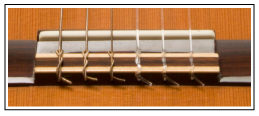Here are step-by-step instructions and a video to help you learn how to string a classical guitar. This technique also works for folk and flamenco nylon-string guitars.
Step-By-Step Guide: How to String a Classical Guitar
- Learn about guitar string basics and the types of nylon guitar strings available, and then purchase a set of nylon guitar strings.
- Remove one old string by loosening the string and then pulling the string gently off the tuning peg. It’s best to change strings one-at-a-time instead of removing all of the strings. Keeping some tension protects your guitar neck.
- Insert one end of the new string into the hole at the bridge. You will need about 1 1/2″ of the string available on the side opposite the sound hole.
- Bend the 1 1/2″ length of string back towards the sound hole and wrap it around the rest of the string (see picture below). Two times is preferred. Keep gentle tension on the long end of the string as you proceed with the next step to prevent the wrap from coming undone. When learning how to string a classical guitar you need to be sure the string is wrapped/tied-off securely. Note that with folk guitars, the folk strings have a plastic ball that goes through the bridge, so it does not require being tied.
- Locate the corresponding peg at the head of the guitar and wrap the loose end of the string around the peg once or twice.
- Insert the end of the string through the hole in the peg.
- Pull the end of the string through the hole.
- Turn the tuning peg away from you to tighten the string. Use a tuner to bring the string up close to pitch and avoid over-tightening the string.
- Once the string is close to pitch, move on to the next string. Wait until you are done changing all of the strings to attempt precision tuning.
The bridge of a classical guitar showing the string windings.
Tune Up
After changing strings, it’s time to tune your guitar. New strings will stretch and need to be brought back up to pitch as you play. This is normal, as nylon strings stretch considerably more than steel strings. They will keep stretching for days, so don’t be alarmed if you need to retune several times until the strings stabilize. Here’s a post to help you learn how to tune your guitar. If you want a high-quality, inexpensive, digital guitar tuner to make tuning faster and easier, check out the PitchBoy. This amazing mini tuner is so portable that it even fits on a key chain!
